Nation with least need for nuclear has most to gain
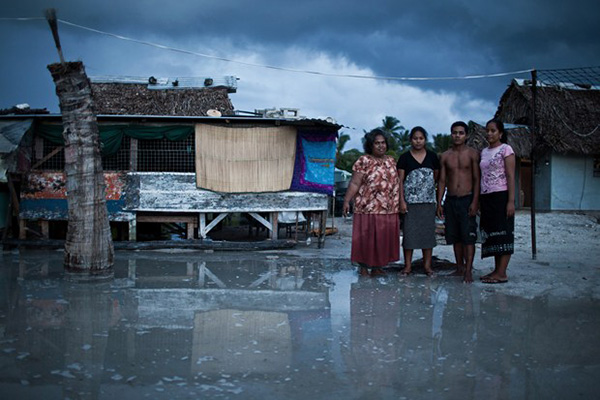
Frontline of Sea-Level Rise: While many parts of Aotearoa are excessively and needlessly exposed to sea-level rise—famously, newly rebuilt parts of Christchurch—many Pacific states are in dire need of assistance, including to help soften the impacts of relocation. Transport between homelands and new sanctuaries, Fiji in the case of these and other I-Kiribati, could well be provided by vessels purpose-designed-and-built in partnership with developed-world Aotearoa and its global-warming-innocent Pacific neighbours. photographer Gary Braasch
Even the pro-nuclear-power Dr James Hansen doubts Aotearoa needs it:
You happen to be very fortunate and be very wealthy in terms of renewable energy.
But New Zealanders’ future prospects now directly depend upon an unprecedented international mobilisation to radically slash greenhouse gas emissions, and despite the recent China – United States accord, no physical progress is being made—fossil-fuel use continues to increase. While it is true that some parts of the world will be hit harder by anthropogenic global warming than Aotearoa, part of its community of interest, the Pacific island states, are due to be hit possibly the hardest, indeed are being hit already.
It is in New Zealanders’ near-term self-interest to help break the impasse whereby developed countries want developing ones to join them in reining in fossil-fuel use, whereas developing countries want developed ones to go first, given that the countries that led the industrial revolution, and most-benefitted from it, have contributed most to greenhouse-gas levels. The current National Party do-nothing ‘fast follower’ doctrine might appeal to corporate moguls and small business owners alike, but longer-term the business world won’t magically escape the destruction of a liveable climate.
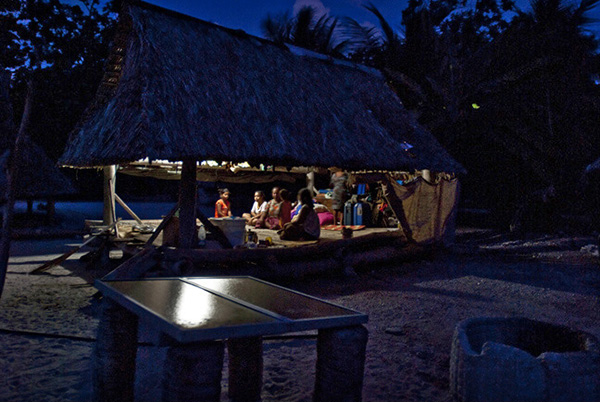
Perfect Place for Photovoltaic: While photovoltaically generated power has only a small useful role to play to in reducing greenhouse gas emissions globally, it is the perfect, though expensive, technology for small isolated communities such as those already on the back foot thanks to excessive fossil-fuel use elsewhere, and where the only electricity otherwise available is generated from excessively expensive diesel, imported with difficulty. Rather than install them on their own roofs, New Zealanders with capital to spare for photovoltaic panel installations could consider sponsoring their installation to aid such as this I-Kiribati family. photographer Gary Braasch
Aotearoa is uniquely placed and equipped to demonstrate that a developed country can thrive on a tiny fossil fuel diet. Historically the country is undaunted about punching above its weight when it comes to reform, being the first country to democratically enfranchise women. It also has an impressive history of hydropower development, due to a combination of natural resources and the preparedness of government to roll up its sleeves and develop critical, world-class infrastructure, such as its once 91%-renewable electricity generation. By playing to its strengths, Aotearoa could best secure its long-term future by being a fast leader. Because, not only is a survivable climate an absolute business prerequisite, opportunity abounds for businesses on the frontline of practical climate action—provided that Aotearoa becomes synonymous with radical and effective climate action.
If Aotearoa was to aspire to lead the world in climate action, its goal couldn’t simply be 100% low-carbon electricity, but 100% low-carbon energy, which means generating a whole lot more electricity, for example to power buses and other electric vehicles, and rail where that is practicable. For example, for a country whose importers and exporters have no foreign rail connection, airport and port electrification is of particular importance, for which:
A supply of reasonably priced, reliable power is the No. 1 priority for large-scale electrification efforts at ports, including shore power for vessels. A number of ports have built infrastructure to electrify cruise ships while at berth.
But the likes of ports and airports won’t be electrified by photovoltaic panels—the cost of power from that source, even if a surplus was available night and day, rain and shine, is prohibitive, and despite the hype the price will fail to fall fast enough to power large-scale electrification. These are just a few of the myriad reasons scientists and others who have exhaustively studied the challenge of reducing fossil-fuel use are increasingly speaking out about the need for environmentalists to rethink their ideological opposition to nuclear power. Last month, 75 ‘conservation scientists’ signed an open letter supporting broad conclusions drawn in the article Key Role for Nuclear Energy in Global Biodiversity Conservation published in Conservation Biology, in which it is argued:
…that the full gamut of electricity-generation sources—including nuclear power—must be deployed to replace the burning of fossil fuels, if we are to have any chance of mitigating severe climate change.
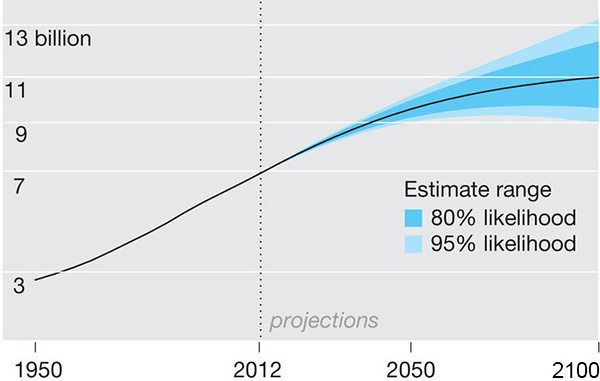
Ecocidal Trajectory: The self-serving assertion that population would decline with economic growth has been good for business in the short term, but is leading humanity into dangerous territory, by both contributing to anthropogenic global warming and exposing billions to an increasing at-risk-from-global-warming global food supply. chart National Geographic
Of course, the world’s most famous conservation scientist is Sir David Attenborough, but rather than advocate the use of nuclear power, he consistently campaigns for the scaling back human population to a level that would allow rather more of species than might otherwise be the case to avoid anthropogenic extinction. This is a not unpopular proposition, but one that is consistently objected to by the Left, which insists on seeing ‘population control’ as anti-Third-World-proletarian. This pass-the-parcel response to anthropogenic global warming serves only the status quo. When the full horror of runaway global warming is revealed, it will be as perplexing in hindsight to young people as it was to baby boomers that Germany was allowed to remilitarise unimpeded for global conquest, prior to World War II. The principal difference will be the scale of suffering. A possible 78 million died as a result of World War II. With some 2100 population projections being nearly double today’s 7.3 billion, the death toll following widespread global-warming-caused crop failures would eclipse any and all of those caused by war and pandemic in the twentieth century.
Unfortunately, the only seriously, albeit unevenly, pursued response to human overpopulation, the provision of family-planning resources, is incapable of reducing greenhouse gas emissions sufficiently quickly for this to be helpful in averting runaway global warming. A study by a pair of scientists who specialty is the study of species extinctions, has concluded that population reduction is no quick fix in reducing fossil-fuel use. Even war or pandemic—such as if the deadly H5N1 Bird Flu gained the few mutations necessary for it to become airborne—saw an additional 1.5 billion people to further confound the goal of reducing greenhouse gas emissions to sustainable levels:

No Help from Grimmest of Reapers: Despite it claiming possibly six times as many lives as the First World War, the 1918 Pandemic barely dented the World’s inexorable population growth. Admittedly, the harder global warming hits, the greater the likelihood of regional famine and/or war, being followed by pandemic on the scale of the 200-year impact of the Black Death. chart McGraw-Hill
…researchers tested what would happen if 2 billion people died over the course of a five-year period in the mid-21st century, for example by a war or pandemic. They calculated the world’s population would still grow to 8.5 billion by 2100.
An event claiming two billion lives would be four times as deadly, relatively, as the 1918 Pandemic, which in turn killed up to six times as many as the insatiable world war that set up the conditions for it.
Meantime, those inclined to believe that the planet would be better off if Homo sapiens sapiens sent itself extinct are scheduled for disappointment, in any afterlife—if the species was to succeed in wiping itself out, by precipitating runaway global warming, a recent study confirms the hypothesis that humanity could take most, if not all, of the natural world with it.
If global warming wasn’t a consideration, the 100–1000 times, and headed towards 10 000 times, greater rate of species extinction would still be reason enough to return human population to something closer to what it was post the First World War, when it was a little under two billion. Just how many billions the planet can bear long term depends upon the impact of the lifestyles of those people and how much of the natural world is valued, but clearly population, long term, has to be stabilised a level much lower than that of today. Logically then, given that fossil-fuel use has to be urgently and radically reduced, it makes sense to reduce population to an agreed sustainable level, by the fastest means socially acceptable.
Fortunately, lest some harbour sinister thoughts of a Final Solution, there is only one way in which population can be quickly reduced, and that is by a temporary, partial, voluntary global breeding moratorium. An absolute breeding moratorium would result in a global population, by 2050, of 5.5 billion, against the United Nations projection of 9–10 billion. That would have an enormous impact on greenhouse gas emissions, because not only would energy use be radically curtailed, demand for concrete and steel, a major source of greenhouse gas emissions, would plummet, given that existing housing, office and factory stock would quickly begin to be freed up, within nine months of the moratorium being adopted.
The weakness of the breeding moratorium approach, it being voluntary, is also its strength—it would only work as a grassroots phenomenon, led by the young. If young women were to elect to take this radical action, on behalf of humanity and its fellow species, older people would owe it to them to support that generation in every possible way while they got on with the gigantean task of building a fossil-fuel-free future—the job the parents and grandparents have conspicuously failed to do these last four decades.

Can’t Afford to Solve One Problem at a Time: When national economies failed their people in the mid-twentieth century, the state invested in the future, pulling the poorest out of poverty and stimulating spending. Practical climate action, such as tree planting on every scrap of unproductive land, for a multiplicity of purposes, is a mother-of-all opportunities to banish poverty. Meantime, inappropriate renewable energy strategies, such as that pursued by Germany by subsidising photovoltaic power, is simply driving the poor further into energy poverty. Infographic Child Poverty Monitor
But while a rapidly falling population would take much of the sting out of fossil fuel demand, the urgent reality is that the world can’t afford to solve one problem at a time. Fossil-fuel use must be rapidly and radically reduced at the same time the billion currently living without electricity is provided with it, while also electrifying as much that is currently fossil-fueled as is practicable, while replacing all fossil-fueled electricity generation, and while simultaneously addressing myriad pressing problems such as child poverty, and reducing greenhouse gas emissions while increasing food production. This means repowering with nuclear power at least as quickly as France did, and of course France could have done that even more quickly, not to mention economically, if she’d not been hell-bent on becoming a nuclear superpower.
Had mutually-assured-destruction not averted it, a third world war fought with nuclear weapons might have destroyed much of humanity and the natural world. Although it was hypothesised, and popularly believed, that a nuclear holocaust could spell the end of humanity and permanently poison the planet to life, anthropogenic global warming holds an altogether more convincing set of scenarios whereby such destruction could be mutually assured, even short of boiling off the earth’s oceans—anthropogenic ocean acidification has as dire a potential to disrupt life on the Blue Planet as does climate disruption, sea-level rise, coral bleaching, terrestrial species extinction and the myriad other global warming impacts put together. And while the world certainly was, for a time, poised perilously close to the nuclear brink, large-scale war only ever a threat, whereas global warming is fully underway and is claiming casualties daily. Even Air Asia’s flight 8501 is likely to be recorded by history as a global warming casualty, brought down by an extreme weather event, the likes of which climate scientists have long warned will increase in intensity and frequency.
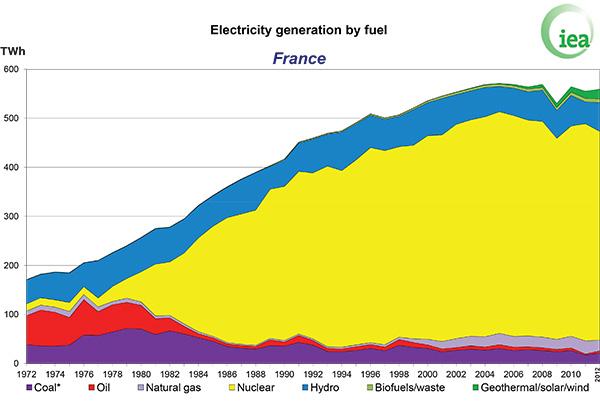
Blinded By le Bombe: While France, deservedly, was receiving international opprobrium for prosecuting her nuclear weapons development programme, she was diligently cleaning up her electricity generation. If the major powers had energy profiles as fossil-fuel-free as France, the world today would not be teetering perilously on the precipice of runaway global warming. chart International Energy Agency
After the many false dawns, world leaders are beginning to talk the talk, but given Barack Obama’s now lame-duck presidency, it remains to be seen if the China–America accord represents a turning point. Meantime, possibly revered more than the equally deserving Pope, Sir David Attenborough, in his New Year’s Day message, proclaims:
Never in the history of humanity in the last 10 million years have all human beings got together to face one danger that threatens us…
Had nuclear power emerged entirely independently from the holocaust unleashed on Hiroshima and Nagasaki, there is absolutely no doubt that most developed countries would, long since, be enjoying fossil-fuel-free power, à la France. Instead, the rightly anti-war Campaign for Nuclear Disarmament and every major environmental group that has followed, have seen the nuclear weapons and nuclear power as inseparable. However, a fundamental misapprehension about radiation and health must be confronted before most opponents can begin to see nuclear power objectively. Not only does a nuclear power plant emit a hundredth of the radiation of a similar-sized coal-fired one, radiation, up to levels considerably higher than those in most homes and workplaces, are not merely harmless, but positively beneficial to health. This counterintuitive, convenient truth is difficult to swallow, particularly for the generations raised in the shadow of Hiroshima–Nagasaki. But even Chernobyl resulted in a fraction of the fatalities and cancers that fossil-fuel use causes annually. The reason, of course, that human life is so tolerant of low-level radiation, is that it evolved with it, and indeed needs it to stimulate the immune system. Historically, people have flocked to spas to soak in their health-restoring, mildly radioactive waters.
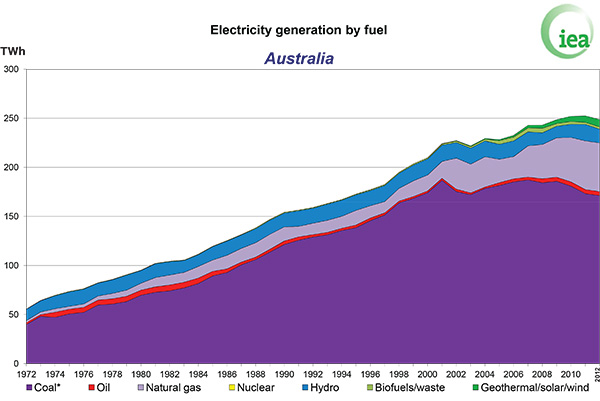
Country with Most Carbon on its Hands: Australia is the greatest fossil-fuel outlaw unhung, both in respect to its own fossil-fuel use and its unprincipled export of it. The continent is the world’s third largest exporter of uranium, yet it lacks the conviction to use it itself to fuel a clean up its electricity production. chart International Energy Agency
So now, when humanity’s survival depends upon its rapid universal deployment, an artefact of history is successfully preventing it—better dead that nuclear powered; better dead than revisit the ideological basis for opposing nuclear power. The exceptions are China and India which, fortunately for the balance of humanity, are taking a more rational and practical approach to low-carbon electricity generation.
Given the mileage she has made on the world stage from her ban on nuclear-powered ships, Aotearoa is in a uniquely powerful position to send the strongest climate action signal possible, by committing to nuclear power coupled with an aggressive policy of electrification. History might then record that action as the tipping point from which humanity narrowly averted runaway global warming. By being at the forefront of saving a survivable climate, not only will Aotearoa save herself, but her electrification expertise, and other practical climate action expertise, will be sought worldwide.
Thus, paradoxically, the country with the least need of it, has most to gain, by deploying nuclear power.

This is an excellent and compelling argument which deserves very wide distribution, serious discussion, and urgent action.
This article is the best I have seen on this topic and the issues are well thought out and clearly expressed. I fully support his argument. The Kaipara area has already been ear-marked for a possible nuclear power station site. It should be brought into the arena for public discussion again.